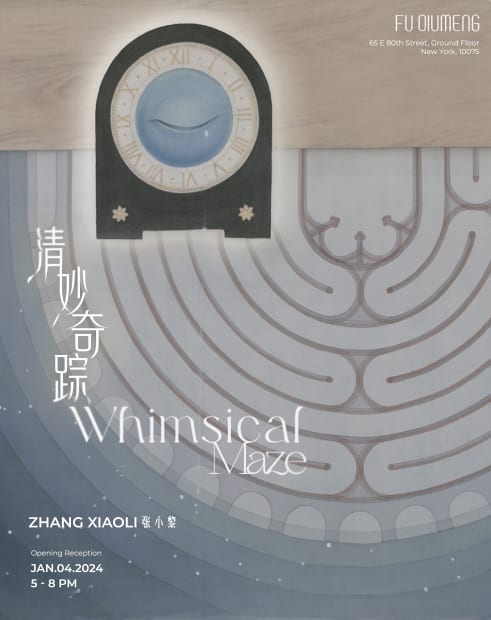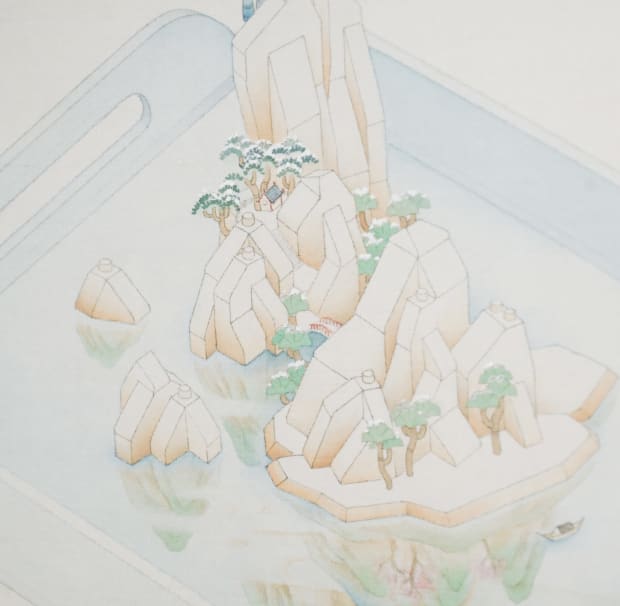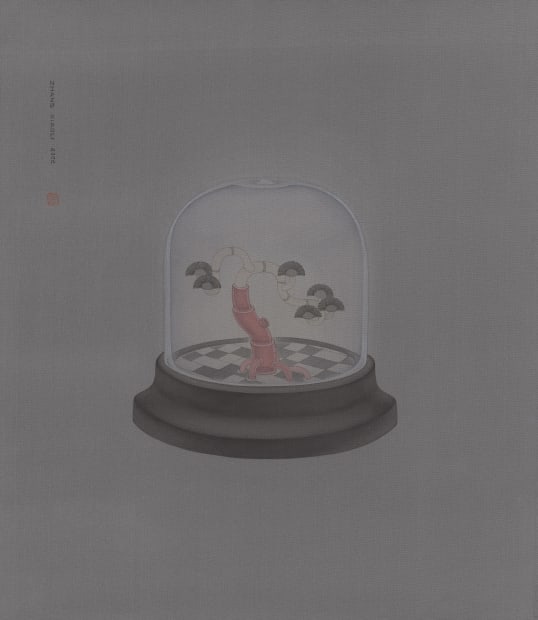-

-

Learning after Facsimileing, 2014
Chinese ink and colour on paper
66 x 25 cm
-

Detail of Spring and Winter in the Blue Tray 蓝托盘里的冬和春
-
On view through February 3rd,
Whimsical Maze is an odyssey through Zhang Xiaoli's artistic journey in three phases:
-
LEGO Landscape Series
The 'LEGO Landscape' series from 2014 reflects her explorations during her student days, extracting the symbolic aspect of traditional Chinese paintings from the Qing Dynasty's 'The Mustard Seed Garden Manual of Painting'. By replacing traditional landscape components with LEGO pieces, she constructs a light-hearted, playful, and ancient-styled unique landscape, engaging in a contemporary Western Pop dialogue with tradition, proposing new concepts and understandings of classical Eastern landscapes. -
 Mountain Villa of Embracing Beauty 环秀山庄, 2022-2023Chinese ink and colour on paper 纸本水墨设色71 1/2 x 48 1/2 in
Mountain Villa of Embracing Beauty 环秀山庄, 2022-2023Chinese ink and colour on paper 纸本水墨设色71 1/2 x 48 1/2 in
181.6 x 123.2 cm -
Boxed Landscape Series
The 'Boxed Landscape' series, starting in 2015, incorporates her experiences living in Hong Kong, depicting and capturing abstract things collected by consciousness, ranging from fragments of memory and experience, conceptual landscapes, to concepts related to alchemy, molecular biology, and geometry. Seemingly unrelated fragments form distant yet tight connections, moving between boundaries and infinity, creating ambiguous links and self-contained situations. -

Spring and Winter in the Blue Tray 蓝托盘里的冬和春, 2018
Chinese ink and colour on silk 绢本水墨设色
22 x 22 in
55.9 x 55.9 cm
-
 Learning from Joseph Cornell 向康奈尔学习, 2022Chinese ink and colour on silk 绢本水墨设色16 1/2 x 14 in 41.9 x 35.6 cm
Learning from Joseph Cornell 向康奈尔学习, 2022Chinese ink and colour on silk 绢本水墨设色16 1/2 x 14 in 41.9 x 35.6 cm -
-
Mysticism Series
The 'Mysticism' series, starting in 2019 after she moved to Beijing, represents her creative explorations. In the immersion of landscape traditions, she began to contemplate the universal laws beyond the concrete, exploring the gathering and separation, transformation, and generation of objects, merging natural elements such as water, fire, wood, and stone, and using the Möbius strip to symbolize their infinity, continuity, and complexity, constructing a world of unconventional experiments. These works are not only a testament to her personal growth and exploration but also symbolize the juxtaposition of reality and ideals, and the mazes and portals across multiple dimensions of time and space, leading viewers into one mysterious and profound fantasy realm after another.
-
-
Infinite Loop
Zhang Xiaoli's "Infinity Loop" draws inspiration from topology, notably the Möbius strip in topological geometry. This structure, with one surface and boundary, symbolizes infinity like an endless loop, embodying eternity and continuous flow. The artwork intricately combines elements like water's flow, fire's intensity, wood's resilience, and stone's stability. These elements intertwine with the Möbius strip's infinity and topology's connectivity, representing the physical world's cycles of coming together and transformation. Zhang Xiaoli uses these interactions to explore the delicate link between nature and abstract concepts, creating a unified entity that blends the real and the ethereal, form and concept. -
-
 The Enigma of Time 时间之迷, 2022Chinese ink and colour on silk 绢本水墨设色58 x 25 1/2 in
The Enigma of Time 时间之迷, 2022Chinese ink and colour on silk 绢本水墨设色58 x 25 1/2 in
147.3 x 64.8 cm -
-
 The Story of Stones 石头记, 2021Notebook 笔记本8 1/4 x 23 5/8 in 21 x 60 cm
The Story of Stones 石头记, 2021Notebook 笔记本8 1/4 x 23 5/8 in 21 x 60 cm -
-
-
 Zhang Xiaoli, Duo 复调 , 2021
Zhang Xiaoli, Duo 复调 , 2021 -
 Zhang Xiaoli, Infinite Loop 江山无尽, 2023
Zhang Xiaoli, Infinite Loop 江山无尽, 2023 -
 Zhang Xiaoli, Learning from Joseph Cornell 向康奈尔学习, 2022
Zhang Xiaoli, Learning from Joseph Cornell 向康奈尔学习, 2022 -
 Zhang Xiaoli, Mobiüs II 莫比乌斯 II, 2023
Zhang Xiaoli, Mobiüs II 莫比乌斯 II, 2023 -
 Zhang Xiaoli, The Dawn 既白, 2021
Zhang Xiaoli, The Dawn 既白, 2021 -
 Zhang Xiaoli, The Enigma of Time 时间之迷, 2022
Zhang Xiaoli, The Enigma of Time 时间之迷, 2022 -
 Zhang Xiaoli, The Special Moment 特别的时刻 , 2019
Zhang Xiaoli, The Special Moment 特别的时刻 , 2019 -
 Zhang Xiaoli, The Story of Stones 石头记, 2021
Zhang Xiaoli, The Story of Stones 石头记, 2021 -
 Zhang Xiaoli, Box unlimited 无限展开的盒子, 2023
Zhang Xiaoli, Box unlimited 无限展开的盒子, 2023 -
 Zhang Xiaoli, Crawling Pine 爬行的松, 2022
Zhang Xiaoli, Crawling Pine 爬行的松, 2022 -
 Zhang Xiaoli, Mountain Villa of Embracing Beauty 环秀山庄, 2022-2023
Zhang Xiaoli, Mountain Villa of Embracing Beauty 环秀山庄, 2022-2023 -
 Zhang Xiaoli, Spring and Winter in the Blue Tray 蓝托盘里的冬和春, 2018
Zhang Xiaoli, Spring and Winter in the Blue Tray 蓝托盘里的冬和春, 2018 -
 Zhang Xiaoli, The Portrait 肖像, 2023
Zhang Xiaoli, The Portrait 肖像, 2023 -
 Zhang Xiaoli, Landscape 山水, 2023
Zhang Xiaoli, Landscape 山水, 2023 -
 Zhang Xiaoli, The Blue Rock 蓝石头, 2023
Zhang Xiaoli, The Blue Rock 蓝石头, 2023 -
 Zhang Xiaoli, The Energy Ladder 能量阶梯, 2023
Zhang Xiaoli, The Energy Ladder 能量阶梯, 2023
-
-
About Artist
Zhang Xiaoli
Zhang Xiaoli, 4 January - 3 February 2024
Join our mailing list
* denotes required fields
We will process the personal data you have supplied to communicate with you in accordance with our Privacy Policy. You can unsubscribe or change your preferences at any time by clicking the link in our emails.




























